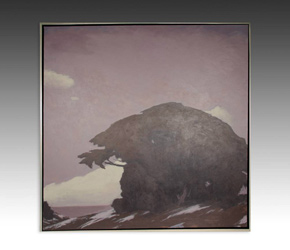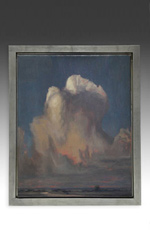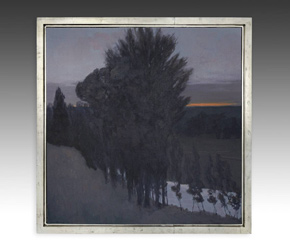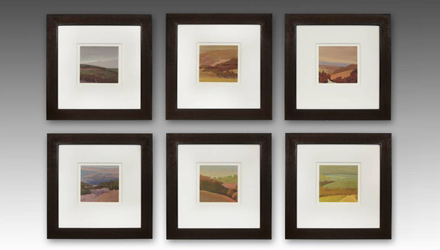Brian Sindler - Beyond Plein Air Painting
PRIMITIVE - Friday, January 13, 2017By Glen Joffe & Misaki Imagawa
 |
|
Who is to say that the things we see – all the colors, shapes and textures of the world – are viewed the same way through every eye? Is the green you see the same as the green I see? Recent research has suggested it's not, and further, that the perception of color is actually derived from experience. Needless to say, no two people have identical experiences, even identical twins. We are all individuals; yet through the work of artists we can glimpse different interpretations of the world – at least as they see, live, breathe and feel their seemingly endless viewpoints.
 |
|
Brian Sindler is an award-winning American artist whose works embody the essence of landscape painting. They have been called "landscape renditions." Sindler grew up in a family immersed in art. Early on he delved into music, fine-tuning the chords of creativity over the years. Later at the American Academy of Art and The School of Representational Art, a famous French-style atelier, Sindler studied traditional figure painting. Some of his work from this time period has a photo-realist quality. Sindler might have stayed with figure painting and drawing, except one day a peer invited him to leave the atelier and paint under the sun. Mildly frustrated with his initial attempts at landscape painting, he decided to return to the model named Nature until he 'got the hang of it.' Before he knew it, some ten years had passed and never once had he missed the static quality of figure drawing. In painting landscapes he found a home.
It would be easy to label Sindler as a landscape or plein air (open air) painter, but his works encompass a far greater depth and complexity to be relegated to a single style or method of creation. Sindler has developed a visual language stretching across the borders of landscape painting, conceptualism, realism, and even surrealism. He has absorbed and made his own, countless influences he has come across.
 |
|
Shapes, color and light are central themes in Sindler's artistic process while composition and design are crucial to his working process. From initial sketches to the finished piece, he thinks in terms of shape, be it a mass of trees, the ground, water, sky, clouds or architectural structures. When he first goes outside, Sindler may make as many as a hundred sketches, ultimately choosing only a handful to translate into paintings. There are a thousand details in any given landscape, but not all of it is relevant to his work. Editing is critical to his vision, which is as much about what is omitted as included. His sketches represent the schematic simplification of a location; and in the next step of his working process he selects and refines which sketch design to pursue. Finding the right “armature” for a painting is half the battle to Sindler.
Color is a tool Sindler uses in his works to evoke moods rather than dutifully replicate views. In fact, he rarely paints a scene with colors exactly as he sees them. Instead, he observes nature and light at different times of the day to see their effect on the landscape. Most often he uses colors encountered at dawn and dusk to temper the mood and atmosphere of his paintings, making them truly unique. The subtlety of colors and shades infuses his work with a sense of fluidity that makes one almost believe a breeze could rustle the leaves in his canvas at any minute or shift a cloud over the moon.
.jpg) |
|
To Sindler, individual limitations are not restrictions, but instead, opportunities to expand creativity. For example, his color palette is composed of only five colors: white, yellow, two kinds of red and blue; yet the depth and complexity of his paintings are a tribute to his dexterity of mixing those basic pigments. In terms of format, determining the size of his canvas is one of the first things Sindler does. In many of his large-scale paintings, his subjects are depicted up close and center stage whereas in his smaller formats, he tends to zoom out and portray wide vistas and rolling landscapes, the opposite of what one might expect. He discovered this in a series of gouache paintings he did after an inspiring trip to Tuscany, Italy in 2008. Sindler was taken by the beautiful undulating hills, amazed by their heights and the perspectives they offered, an experience he translated into engaging imagery, which later became the basis for a series of prints published by PRIMITIVE Modern. Painting with gouache was a new experience for Sindler, distinctly different from oil and acrylic. The fast drying nature of gouache required him to paint in a short, continuous time frame, infusing each piece with a singular impulse of emotion and artistry.
.jpg) |
|
Sindler's most recent "momentum," a series of Nocturne paintings deviates from his usual subject of natural landscapes. They portray a wide range of outdoor scenes - port towns shrouded in fog and dusky darkness, bridges and other landmarks caught at the precise moment when the sun disappears leaving a moody, engaging atmosphere, and urban landscapes allowing us the opportunity to see skyscrapers as well as private homes differently. He perfectly captures the moments when objects appear to blur at the edges and merge in dim twilight, leaving only a vague image or outline of a shape. As with his landscape paintings, these are not mere documentations of scenes as the sun has vanished; but instead, recreations of certain moods that engage the viewer's mind and imagination through the use of deliberate obscurity.
What one person may see and take from Sindler’s Nocturne paintings may be different from another, but the impressions they leave on viewers are all equally powerful and lasting. Like all his works, the Nocturne paintings evoke feelings, thoughts, and memories – familiar and comforting on a visceral level and yet new, stimulating and inspiring on another. They remind us that the most important element in vision is light; and his ability to capture moments where light fades and is replaced by mood is both mesmerizing and hypnotic. It would be trite to say he allows us to witness everyday scenes in a new light. Rather, his ability to capture everyday scenes in diminished natural light causes us at first to visually examine his paintings, but ultimately, to review our own reactions to the scenes he depicts. In examining his Nocturnes, viewers may discover the familiar or the distant. They may find solace, joy, or even tragedy; but it is this transference from the visual to the emotional – from the public to the personal – that in part sets Sindler’s work apart from other artists, not just those noted for Plein Air painting.
Demonstrating the mark of artists worth collecting, Brian Sindler has created a distinct visual language that prompts the viewer to contemplate the mood he is conveying rather than the faithfulness of the scene he is depicting. His work exhibits a style unique among outdoor painters. He is less concerned about accurately duplicating landscapes than in conveying what initially inspired him and how he felt when painting them. From a world only he can depict, Sindler shows us through a potent mix of skill and sensitivity what it is like to view his world – not as he sees it – but as he feels it; and in turn, for us to give him an in-depth reaction to what we feel ourselves.
 |